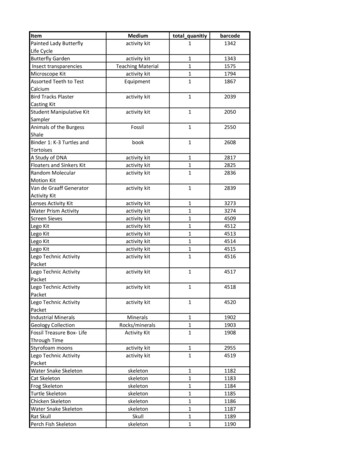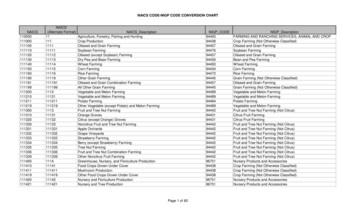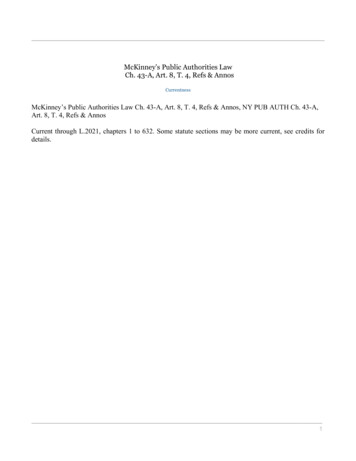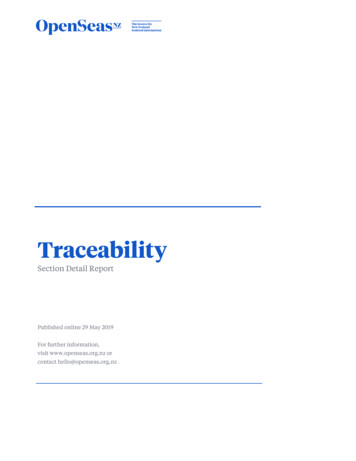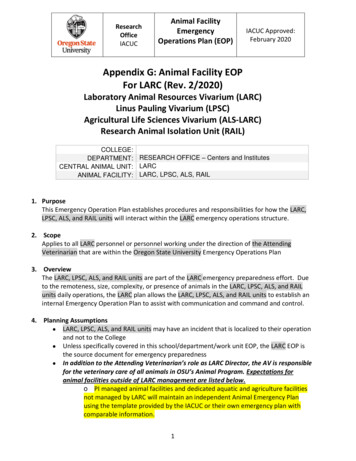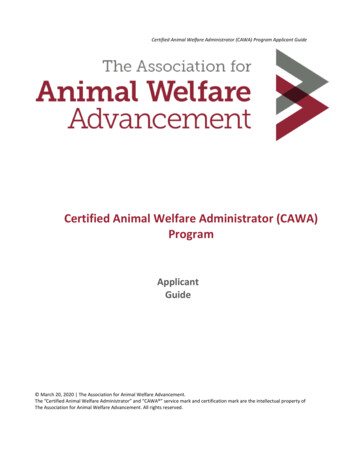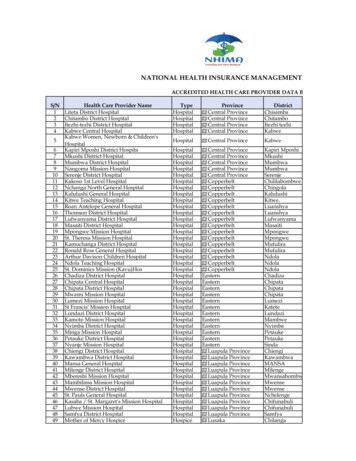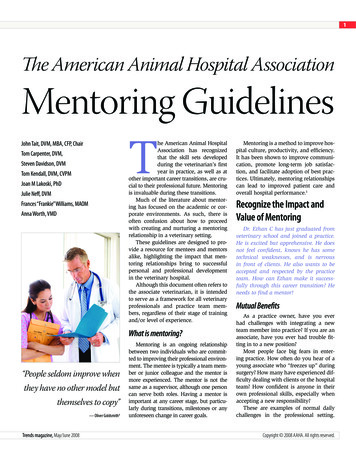
Transcription
1The American Animal Hospital AssociationMentoring GuidelinesTJohn Tait, DVM, MBA, CFP, Chairhe American Animal HospitalAssociation has recognizedthat the skill sets developedduring the veterinarian’s firstyear in practice, as well as atother important career transitions, are crucial to their professional future. Mentoringis invaluable during these transitions.Much of the literature about mentoring has focused on the academic or corporate environments. As such, there isoften confusion about how to proceedwith creating and nurturing a mentoringrelationship in a veterinary setting.These guidelines are designed to provide a resource for mentees and mentorsalike, highlighting the impact that mentoring relationships bring to successfulpersonal and professional developmentin the veterinary hospital.Although this document often refers tothe associate veterinarian, it is intendedto serve as a framework for all veterinaryprofessionals and practice team members, regardless of their stage of trainingand/or level of experience.Tom Carpenter, DVM,Steven Davidson, DVMTom Kendall, DVM, CVPMJoan M Lakoski, PhDJulie Neff, DVMFrances “Frankie” Williams, MAOMAnna Worth, VMDWhat is mentoring?“People seldom improve whenthey have no other model butthemselves to copy”— Oliver GoldsmithATrends magazine, May/June 2008 Mentoring is an ongoing relationshipbetween two individuals who are committed to improving their professional environment. The mentee is typically a team member or junior colleague and the mentor ismore experienced. The mentor is not thesame as a supervisor, although one personcan serve both roles. Having a mentor isimportant at any career stage, but particularly during transitions, milestones or anyunforeseen change in career goals.Mentoring is a method to improve hospital culture, productivity, and efficiency.It has been shown to improve communication, promote long-term job satisfaction, and facilitate adoption of best practices. Ultimately, mentoring relationshipscan lead to improved patient care andoverall hospital performance.1Recognize the Impact andValue of MentoringDr. Ethan C has just graduated fromveterinary school and joined a practice.He is excited but apprehensive. He doesnot feel confident, knows he has sometechnical weaknesses, and is nervousin front of clients. He also wants to beaccepted and respected by the practiceteam. How can Ethan make it successfully through this career transition? Heneeds to find a mentor!Mutual BenefitsAs a practice owner, have you everhad challenges with integrating a newteam member into practice? If you are anassociate, have you ever had trouble fitting in to a new position?Most people face big fears in entering practice. How often do you hear of ayoung associate who “freezes up” duringsurgery? How many have experienced difficulty dealing with clients or the hospitalteam? How confident is anyone in theirown professional skills, especially whenaccepting a new responsibility?These are examples of normal dailychallenges in the professional setting.Copyright 2008 AAHA. All rights reserved.
2This special relationship inspires thepractice team. Mentoring helps newemployees learn effective communication and teamwork. The positive culturecan encourage candid, solution-focuseddiscussions of difficulties in the practice.Another great benefit is that with therapid advance of veterinary knowledge,mentors will be able to learn the mostup-to-date medicine from their recentlytrained colleague.11Benefits to the MenteeConsider mentoring as a structured solution to address these concerns in a positive yet practical manner.Through acknowledgement of personal and professional goals, mentoringis beneficial to both mentee and mentorin sustaining growth, accomplishment,and long term satisfaction. Mentoring isa key activity by which employers cansuccessfully facilitate a new employee’sentry into the hospital environment. Thementor provides valuable knowledge,expertise, and support, while the menteeprovides enthusiasm and an open mind.This solution-focused attitude reflectspositively on the entire hospital.Both mentee or mentor can broaden theother’s understanding of complex issues.Mentoring includes the opportunity toconstructively deal with sensitive ethicalissues in the practice setting, particularlywhere there is no one right choice.2,3 Effective mentoring also has a positive impactin non-technical areas, such as improvedharmony among practice team members,enhanced self esteem, better work habits,and personal growth.4,5 Only when a veterinary team is working at their best canthey offer their best to their patients andclients, which is what motivates us all toexcellence in practice.Mentoring is highly desired by associate and new graduate veterinarians.1,6,7Research in other professions shows thatmentoring can have specific measurableoutcomes. For example, the Nature Publishing Group created awards to honormentoring activities in research. Nature discovered that exemplary mentors were alsoexemplary teachers. They also found thatthe individuals who developed the mostoutstanding careers had first experiencedtheir future mentors as teachers.8,9,10Does it cost too much to mentor, oris it more costly to ignore the benefits ofthis relationship? Whether as mentee ormentor, take advantage of all the mentoring has to offer.Dr. Ethan C recognizes that he needsto find a mentor. He thinks of Dr. DianeW, a veterinarian at his practice whomhe admires greatly. Will she see the benefit to becoming a mentor?Dr. Diane W is a successful and experienced veterinarian. She is looking forways she can build better relationshipsand help to develop new talent in thefield of veterinary medicine. She recognizes that Ethan is a talented junior colleague. She is optimistic about his career,yet has concerns about the potential timecommitment of being a mentor.Benefits to the MentorThe importance of building successfulrelationships with new members of theveterinary profession is often unrecognized. A culture of continuous mentoringcan be an effective strategy to improveboth the recruitment and retention of toptalent to your practice. New team members will become acclimated more quickly,increasing their level of satisfaction andleading to higher-quality patient care.All team members can benefit frombeing mentees. This is particularly truefor new veterinarians. The transition fromstudent to practitioner can be an overwhelming undertaking. During this timeit is valuable to have colleagues who arepersonally and professionally supportive.If you are a recent graduate, you willfind that investing in yourself early in yourcareer by seeking guidance will allow youto establish medical, interpersonal andbusiness skills. Your mentor will be aninvaluable resource and source of supportwhen you encounter difficult or challenging situations both within and outside ofveterinary practice, enabling you to quicklybecome a part of the veterinary team.As a mentee, you will be encouragedto think and manage independently. Yourmentor may not have all the answers, butmay provide understanding and empathythat give you the courage and confidenceto move forward.The Heart of the MentoringRelationshipDr. Ethan C is impressed by Dr. DianeW’s enthusiasm, knowledge, confidenceand poise. He asks Diane to serve as hismentor. Diane agrees to take on Ethan asa mentee for a 12-month period. Ethanis ecstatic to have someone in his cornerduring this juncture in his career, and healready feels much more confident.The best mentoring relationships arebuilt on a foundation of mutual effort,respect, trust, and the courage to com-Trends magazine, May/June 2008
3municate openly. There is shared respectand appreciation of the skills, wisdom,and life experiences each party brings tothe relationship. To achieve that successas you embark on a new mentoring relationship, it will be critical to establisha framework for your discussions. Thisincludes consideration of boundaries,commitment to the highest standards ofpersonal and professional integrity, anda willingness to provide the necessaryprotected time for mentoring.12Mentoring relationships often includediscussion of both professional and personal issues of a difficult nature. Creatinga successful and productive relationshiprequires a mutual sensitivity and commitment to creating a safe, confidentialenvironment, which reflects the highstandards of ethical practice.Time constraints are often expressedas a reason for not embarking on a mentoring relationship. An effective mentoring relationship doesn’t require excessive time. Planning together to establishshared goals and expectations as well asmeeting times will make time more manageable. Reviewing progress on a regularbasis enhances confidence in the sharedcommitment. For most, the benefits ofhappy, productive and well-trained teammembers outweighs the time spent.Mentees and mentors both carryresponsibilities in the relationship, asoutlined here.Mutual Responsibilities ofMentee and Mentor Bring enthusiasm, optimism, sensitivity, unselfishness, and respect to therelationship. Make a commitment of time and energy. Strive to be open to new ideas andfeedback. Recognize that in the discussion of“goals,” those goals may includethose of the mentor, the mentee, andthe hospital. Commit to and reaffirm the highest standards of professional conduct, including full confidentiality of discussions.Trends magazine, May/June 2008 Reschedule any meeting time thatcan’t be met. Periodically assess and celebrateprogress. Periodically evaluate the mentoringrelationship to see if it should continue, be modified or terminated.Mentee Role and ResponsibilitiesThe mentee should seek to accept fullownership of the relationship as follows: Establishes “vision plan” with help ofthe mentor.7,9 Takes responsibility to “own” therelationship. Discusses and prioritizesprofessional needs and goals. May request help in clarifying goals,finding resources and identifying newdirections. Respects the mentor’s time commitment by identifying, planning, andpreparing issues for discussion. Recognizes that learning clientcommunication skills and medical/surgical skills take time and practice,trusting that confidence will build. Is open to a non-academic perspective in private practice. Clarifies with the mentor the preferred method for conveying thementee’s new ideas about patientcare, client communication, andhospital management. Is willing to share fears and concernswith the mentor, learning that it isacceptable and natural to sometimesfeel helpless, lost, or frightened. Understands the importance of the allteam members and their key role indelivering top quality medical care topatients. With mentor’s assistance, strives todevelop a professional rapport withthe hospital team. Brings ideas to improve communication with mentor, clients, and fellowteam members. Actively pursues opportunities tonetwork. Strives to be a receptive and activelistener, knowing that constructivefeedback is an essential element tocontinuous professional growth.Mentor Role and ResponsibilitiesThe mentor accepts critical responsibilities as follows: Actively listens to the needs and goalsof the mentee, and asks challengingquestions. Helps the mentee establish a visionplan and short- and long-term goals.7 Ensures that the Mentee understandsand commits to the practice mission,vision and values. Strives to learn and practice the ability to give constructive feedback. Appreciates that mentees will oftenneed time and practice to translate their advice and guidance intoimproved skills (surgical, business,and staff/client relations). Helps guide the mentee in medicaldecision making-process, e.g., conferring with doctors within the practiceand with specialists. Give validity tomentees’ observations, using caseexamples. Strives to help the mentee becomefully independent as a professional,recognizing that the mentee hasultimate responsibility for the personaland professional decisions. Encouragesself-directed learning by the mentee. Provides resources and solutions(e.g., internet sites, texts, or networking via professional associations). Helps the mentee learn and improvecommunication skills with clients andteam members, and thus to createpositive professional relationships. Avoids intended or unintended use ofimplied power. For example, mentorsmay also have the role of supervisorof the mentee. In creating a positiveenvironment for both sides, the dualrole of this relationship needs to beacknowledged and respected. Adjusts mentoring to the mentee’schanging needs, such as providingverbal encouragement, demonstratingskills, or just being available if needed.
4Mentoring Action PlanEach mentoring relationship will bedefined by goals and distance. The twopeople may first identify one another,then define the type of relationship theywill create. Alternatively, one person maybegin by defining the type of relationshipdesired, then find someone who can fillthat role.Mentees can have more than one mentor, and mentoring relationships vary inseveral attributes (Table 1). For example,distance may define a mentoring relationship, which can be virtual or face-to-face.Strategies for finding a mentoror menteeChoosing a compatible mentor is critical to the success of the relationship. Thechoice should include someone with thedesire, time and expertise to fill this role.Selection is usually based on these principal attributes: Education and areas of interest,including specialties Ability to communicate effectively Proven leadership and ability todefine goals Other personal and professionalissues The type of mentoring relationshipdesired The time commitment and the outcomes desiredMentors can be chosen from one’sown workplace, elsewhere in the profession, or even outside the profession.Mentees may look to an AAHA practicefor a mentor; AAHA accreditation assuresthe mentee that they are joining a practice that adheres to the highest standardsof patient care.Mentees may talk to school facultyfor ideas, or use their networking skillsand contacts within other associations tomeet potential mentors. They may finda mentor by talking to their employer,peers, and co-workers.The mentor is often a coworker orsupervisor in the practice setting. ThisTABLE 1. TYPES OF MENTORING RELATIONSHIPSFormalIncludes a written agreement, formal meeting times, and involvement in dailyor weekly activities.InformalA relationship without a written agreement or formal meeting schedule.Virtual(distance, via e-mail)Includes emails, chats, phone calls, and other interactions without beingphysically in the same place.Face-to-faceIncludes meeting in a physical location with both parties together.Peer-to-peerColleagues at the same level sharing experiences and knowledge. Friends orco-workers can be informal mentors for personal growth.makes sense when the mentee is developing medical or communications skills. Anew graduate’s ultimate success and longterm career satisfaction may depend onhaving a mentor.1,8 However, there is somedisagreement about whether every practitioner needs to be a mentor. Practitionerswho do not have the time or inclinationto be a mentor can still assist their newestcolleagues with advice and guidance onfinding a mentor or mentors. Also, mentoring is a skill that can be learned andimproved through good training, such asthat provided by AAHA.BSome employers or new associatesmay assume that a mentoring relationship will ensue with the employment ofa new graduate. However, it is critical tomake those assumptions explicit. If mentoring is already part of the clinic culture,the new person will be assured of beingmatched with a mentor by the employer.If a distance relationship is considered,both parties must make an extra effort atcommunication, and it is recommendedthat an occasional face-to-face meetingbe arranged. A common example of mentoring-at-a-distance is the relationshipbetween a teacher and former student.13Another might be when the mentee has aspecific focused goal or project for whichassistance is helpful.How does a mentee ask someone tobe a mentor? When initiating the relationship, a face-to-face meeting is alwaysthe best way to begin your discussion.You may initiate an introductory meetingby sending a letter of introduction fromyourself or a colleague. Then, a followup phone call or e-mail may be used toschedule a meeting.2Once both parties agree to establish amentoring relationship, consider using alist of “action steps” to guide your discussion (Table 2).14,15 Also, discuss commonfears and concerns, focusing on those ofimportance to the mentee (Table 3).Consider creating an agreementA written agreement is consideredessential by some. Others may find a verbal agreement is enough, especially if theyare not employed at the same practice.The absence of a written agreementdoes not decrease the value of the mentoring relationship. However, it is important that both parties have a very clearunderstanding of the intent of the agreement and of their expectations, regardlessof form. Just as work agreements shouldbe fluid and change as needs change, soshould mentoring agreements be viewedas an ongoing process and adjustedaccordingly.Verifying verbal agreements in writingserves as a tool to ensure mutual understanding and to confirm the relationshipwill be beneficial to both parties.8,16 Thementor can get ideas from associates andTrends magazine, May/June 2008
5the practice team about what might beincluded in a written mentoring agreement. A written agreement can be anaddendum to an existing work agreement, or a separate agreement. Consider including mentoring guidelines inemployment agreements, outlining thegoals of the relationship and how thosegoals are to be accomplished. If no written work agreement is in place, resourcesare available for help.16Maintenance of theMentoring RelationshipDr. Ethan C was becoming accomplished at spay surgery. Then he spayedan overweight dog and it did not go well.How can his mentor assist in dealingwith this with this setback? How mightshe provide strategies and a frameworkto restore Ethan’s confidence?Periodic assessment of the mentoring relationship ensures it is on the righttrack. Both the mentor and mentee mayask, “What level of direction and supportis needed for each situation, and how hasthat progressed or changed?”Many factors may affect the mentoring relationship. It is normal to encounter“bumps in the road.” When this happens,examine the possible causes in the samemanner as one examines a sick patient,so diagnosis and treatment can begin.For example, a setback may occur witha client communication or a surgicalprocedure, which reduces the mentee’sconfidence. It is important for the mentor to actively listen to the concerns ofthe mentee. A joint agreement of how tomove forward the next time a problem isencountered will help to reinforce a solution-oriented practice environment that ispositive for all. The mentor’s sharing ofsimilar experiences, providing empathy,or discussing alternative approaches tothe situation may all help the mentee.When combined with an employment relationship, mentoring can taketime that a mentor would normally useto see clients or do surgery. Discuss anyTrends magazine, May/June 2008adjustments in mentor or mentee salary,if applicable.7,16Periodically review and renew thesteps of the “action plan.” Also, practice“preventive medicine,” by being respectful of time and honoring commitmentsto each other. Sustain the relationshipby continuing regular meetings, and bymaking meetings productive through apreplanned agenda. Follow up at eachsubsequent meeting. Acknowledge thatmissed meetings can become a barrierto success, while a rescheduled meetingshows respect for the process and foreach other.Feedback is important for the relationship, but often difficult if emotions becomeinvolved. Mentors and mentees need toprovide mutual feedback in a constructive manner. Positive statements are morepowerful than negative ones. For example,the mentee may be more receptive to hearing that something could be done differently or better, rather than hearing aboutwhat was “done wrong.” Sometimes thementor can gain new insights and solutions to improve the practice by asking thementee what might make the next opportunity more successful.Mentors who are experienced veterinarians will understand that humanrelations are an important part of a successful work environment. It is importantto remember that becoming a part of theteam can be challenging to mentees. Thistransition must be addressed early in thementoring relationship. Staff can be ofgreat support to young veterinarians andshould be used to enhance the mentoringprocess whenever possible.Together, proactively discuss howyou will handle disagreements. Conflicts often arise when mentors are alsothe supervisor of the mentee. Mentorsmust be explicit about which “hat” theyare wearing at any moment. The mentorshould be especially alert to the potentialimbalance in power between the “bossand supervisor role” versus a more tolerant mentoring role. The less experiencedmentee is often “anxious to please theboss” and will need to be guided gentlyto keep the focus on solving the professional issue at hand.One barrier to successful mentoring isthe potential of future competition betweenthe two parties. Competition between colleagues should never be a problem, yethistorically, it is very common, especiallyin adjoining practices. A more positiveapproach is to mentor in a way that encourages collegiality between colleagues. Oneexample might be to create ways for upcoming associates to buy in or merge practicesrather than opening new facilities.Other types of competition may result inwithholding information or valuable skills.Instead, the relationship can be viewed asa method to enhance the contributions ofboth parties to the profession. It is possiblefor the mentee to show appreciation byhelping to mentor new people in the practice, leveraging the mentor’s hard work.Finally, acknowledge and celebrate victories. This is a positive affirmation that therelationship is productive. Your colleaguesand the team will know that mentoringmakes a positive difference by the mutualtrust and respect you accord one another.Evaluating and Ending theRelationshipThe mentor-mentee relationship maycome to an end for many reasons, including accomplishment of goals, having eitherparty move on to a different position, or amutual realization that the relationship isnot productive. The parties may agree thata mentoring relationship be ended whilethe personal or professional relationship ismaintained.A successful outcome is realized whenthe mentor and mentee have reached theirgoals. This should result in an increasedsense of satisfaction and confidence. Thementor feels satisfied from developing asuccessful addition to the hospital team.The hospital gains a more satisfied, confident, skilled employee. An eventual goalis for the mentee to one day become amentor to current and future hospitalteam members.
6TABLE 2. ACTION STEPS FOR THE MENTORING RELATIONSHIPq 1. Initiate a mentoring relationship by mutual agreement.q a. Discuss roles and responsibilities.q b. Collaborate to choose the type of mentoring relationship that best fits your situation.q 2. Get acquainted, optimally by meeting outside of the work environment. Build trust by openly sharingand discussing issues.q 3. Develop mutual expectations and boundaries. Discuss accountability of both parties at the beginningof the relationship. Discuss confidentiality.q 4. Discuss ethics, including conflict of interest issues, and agree upon ethical boundaries. For example,discuss your position on feline onychectomy. When applicable, ensure congruency with AAHA policiesand protocols.q 5.Discuss a vision plan (i.e., overall purpose / long term goal of the relationship)q 6.Establish, clarify, and write down goals to achieve the vision.q a. Define and prioritize areas of greatest needs, with the mentee taking the lead rather thanrelying upon the mentor to define needs for them.q b. Use SMART goals * (Specific, Measurable, Attainable, Realistic, and Timely) for mentor andmentee, as well as shared and/or consistent hospital goals.q c. Personalize goals to fit the needs of the mentee. Examine the mentee’s concerns and fearswhen establishing goals. These fears can lead to the formation of realistic goals to allow thementee to function and move forward with less stress.q 7.Discuss and negotiate a schedule for meeting together.q a. Establish formal meeting times to discuss “how things are going.” Consider beginning on a weeklybasis and continuing at least monthly. Coordinate with the clinic schedule as necessary.q b. Determine meeting location. Mentors and mentees who work together may find that off-sitemeetings are more productive due to minimal interruption.q c. Plan for your discussions, with the mentee taking the lead in planning. Meeting topics could includeissues of concern, areas of accomplishments, progression toward goals, and new challenges. Setaside time to go over specific cases or situations that have come up since the previous meeting.q d. Create a process whereby a mentee can ask for immediate help as needed.q e. If most meetings are virtual, also schedule occasional face to face meetings. Don’t let distance be abarrier. Use email, phone calls, web services, scheduled travel and veterinary events to get together.q 8. Establish a protocol to help the mentee develop new skill sets in areas such as surgery, medial records, clientcommunication, and other areas of interest. For example, during surgery, the mentor may show a mentee aprocedure, have them perform it and be available, and eventually be able to leave the mentee alone.q 9. Discuss expected outcomes and how those will be monitored or measured. Set up an evaluationprocess (including the time, place, and procedure) to evaluate the mentee’s progression towardsgoals. Discuss how both parties will offer new ideas and feedback to each other. The mentor-menteeevaluation is separate from, and should not be confused with, a performance review.q 10. Discuss how to resolve conflict. Conflict naturally occurs because of differences in background ordifferences in medical approaches. Conflict may arise when the agreement is not specific or writtendown. Resolution of conflict should occur in private so self-esteem of both mentor and mentee canbe maintained.q 11. Create a time frame for the relationship that is beneficial to both parties. Clarify a mutually agreeableendpoint or time for renewal of the relationship.q 12. Celebrate progress and accomplishments.* Doran George, There’s a S. M. A. R. T. Way to Write Management Goals and Objectives., Management Review (AMA Forum), November 1981, pps. 35-36Both Drs. Diane W and Ethan C benefited from their relationship. Dianeenjoyed her mentoring role and itsimpact. She has recognized the value inan ongoing formal mentoring programin her hospital. Ethan is a confident andproductive veterinarian. He is well prepared to take on new goals and is looking forward to his next relationship as amentee or mentor.Final ThoughtsWhether you are a first time menteeor a seasoned mentor, your improvedknowledge of and from mentoring relationships can improve your professionalsatisfaction. Mentoring is often a sourceof confusion, or an overwhelming ideathat is difficult to initiate and construct.This document is intended to inform,give structure, and help bring the processto fruition. Also, see the AAHA websitefor additional mentoring resources asthey become available.CVeterinary hospitals are likely tobecome more successful and efficientas these guidelines are implemented. Apractice with a culture of and reputationfor mentoring may have a competitiveedge in attracting new graduates. Thesehospitals can offer better client service,thereby improving the public image oftheir clinic and the profession. That contributes to the ultimate goal of a higherlevel of care for patients.Interested in becoming a mentee? Ifyou are in a career transition, explorebeing a mentee. Find out how a mentorcan assist you in identifying and obtaining your goals as a professional — whilehaving a satisfying and enjoyable careerin veterinary medicine. Look for a clinicthat will provide mentoring for you inyour veterinary career.Interested in becoming a mentor? Yourexperience and wisdom can effectively support and challenge a new colleague — andcontribute to your own satisfaction in supporting your profession. The time you investin mentoring is an investment in yourself,your colleagues, and your practice.Trends magazine, May/June 2008
7We can all share in the excitement ofour potential to better serve the profession. By emphasizing the importance ofmentoring, everyone gains, including thepets and people we serve. Whether asmentee or mentor, enjoy the excitementand impact of that this dynamic relationship — and have fun! nFootnotesA. Oliver Goldsmith, Irish Author & poet 1735-1774.B. Veterinary Leadership Academy and Veterinary Leadership Workshops.See www.aahanet.orgC. www.aahanet.orgReferences1. Roark A. Wilson J. The real value and cost of mentorship.DVM Newsmagazine Oct 1, 2005. pp. 22-26.2. Lakoski, JM On being a savvy mentor and mentee: Ethicalresponsibilities in a mentoring relationship. Endocrine SocietyNewsletter, Vol 6(20): 15-28, 2004.3. Bird, SF. Overlooked aspects in the education of scienceprofessionals: Mentoring, ethics, and professional responsibility.J. Science Education and Technology: 3: 49-55, 1994.4. Bradberry T, Greaves J. The Emotional Intelligence Quick Book.Simon and Schuster 2005.5. Golman D, Emotional Intelligence. Bantam Books, 1995.6. Learn how to become a mentor. Academy of Rural Veterinarians,accessed 1/14/08, available at: www.ruralvets.com/mentoring/default.html.7. Fassig, Samuel M, Ed. Associate’s Survival Guide. AAHA Press,Lakewood, CO 2005. pp
relationship in a veterinary setting. These guidelines are designed to pro-vide a resource for mentees and mentors alike, highlighting the impact that men-toring relationships bring to successful personal and professional development in the veterinary hospital. Although this document often refers to the associate veterinarian, it is intended


